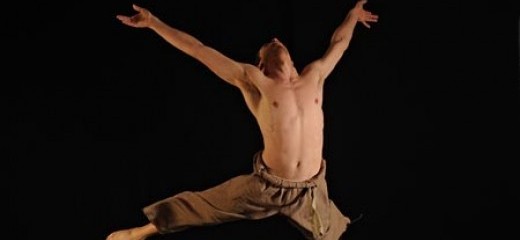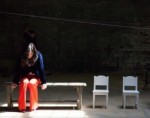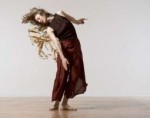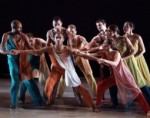
Koresh Scores: Twenty Years and Counting
Twenty years of providing work for dancers is grounds enough for a standing ovation, but Koresh XX Years offered other reasons to rise and applaud. The dancers, an ensemble force to be reckoned with, were at the heart of all of them.Roni Koresh does not call his choreography jazz, but during the past two decades, he has drawn heavily upon that lexicon and its presentational, display-oriented style. Ballet and modern dance elements, though present, seem far less foundational. Koresh’s amalgamation is fast, fierce, linear, and relentless. To achieve it, his performers must be athletes—sculpted and elastic, committed to the choreography’s driving rhythms and intense physical demands. And they are.
The evening’s retrospective included two pieces that first premiered in 1992; the rest were excerpted from the company’s past six years. Preceding intermission, a short video featured Koresh discussing the difficulties of selecting pieces from two decades of work.
He described the process as akin to “choosing between your children.”
Indeed, family was a theme. The Koresh company and the school that serves as its home are run by Roni Koresh and his two brothers, Alon and Nir. The Assistant Artistic Director, Melissa Rector, has been with the group since its inception and was a featured dancer throughout the evening. She also choreographed “Surge,” a display of adolescent feminine power by the Koresh Youth Ensemble, a group of student dancers whose expressions of rage and release were palpable. The inclusion of the Ensemble piece bespeaks Koresh’s commitment both to training and valuing the work of young dancers.
The Koresh company is a tight-knit unit. In this economic climate the advantages of supporting a professional troupe cannot be overstated: dancers paid a living wage to train and rehearse are able to attain precision and fluidity. When Koresh’s choreography demands unison, and it often does, his dancers provide drill team accuracy; indeed, the first company dance of the evening, “Carousel” (1992), showcased the dancers’ stamina and considerable technical skills, with endless full-splitting side kicks, spinning jumps, and turns to the floor, while offering little conceptual or narrative material. To a score of pulsing electronica, dancers rotated through sensual if stylized male-female duets: brief, anonymous interludes reminiscent of the early 90’s club scene. The values on display—telegraphed by simple, tight black costumes, a black backdrop, and stark lighting—were body-as-shape, body-in-motion, and bodies-moving-as-one. Near the end of the piece, I was both attracted to and repelled by the image of one woman enticing four male dancers from the stage while they caressed her, but the troubling moment went un-developed.
The evening was at its most affecting when dancers emerged from their formidable group identity as individual artists. Excerpts from “Looking Back: the Music from the 40’s and the 50’s” (2006) used humor to showcase specific personalities. Dancer Eric Bean was pushed around and berated by a finger-wagging, verbalizing Jessica Daley—a stand-out performer whose sass sparked through the theater. In another excerpt from the same work, he and the three other male dancers sauntered, leapt, and soft-shoed through a light-hearted rendition of Nat King Cole’s “Route 66.” Throughout, the dancers’ breezy camaraderie came across as absolutely genuine, even as their footwork remained meticulously tight. When Bean ended the piece laughing, the audience joined him.
Set to Schubert, a funny-yet-tender excerpt from “Evolution” (2009) stood out. Costumed in beige near-loincloths, dancers Micah Geyer and Melissa Rector explored—in caveman-ish counterpoint to the music—both the extreme and more gestural possibilities of Koresh’s movement vocabulary. Without the pressure of maintaining the company’s perfected and panther-like sensuality or keeping pace with the throbbing percussion of many of the works’ scores, the duet exhibited a very human vulnerability. Held poses were suddenly dropped to the floor, loose-limbed. The dancers more fully gave and received each other’s weight. When Rector crouched on Geyer’s thighs as he walked heavily offstage, the image was perhaps less sexy, but also more provocative, than other moments of male-female intimacy in the repertoire.
“Bang, Bang, Banging” (2011), set to the music of guitarist Leo Abraham, unabashedly used the exact timing and matched lines of dancers Alexis Viator and Asya Zlatina to a new purpose. Pony-tailed, skipping, hand-in-hand: it was as if the ghost-twins from The Shining had survived and then grown to adulthood in the Appalachian mountains. The quirkiness delighted. During the short, high-voltage duet, the two broke from unison rarely, and mostly to change facings. As they danced first in bright, non-confrontational directness toward the audience, and then to and for one another, I thought, “with the tools they have, this company’s potential for innovation is immense.”
Here’s to the next decade of Koresh—may it be one of continued exploration.
Koresh Dance Company, XX Years, Suzanne Roberts Theater, December 1-4, 2011. No further performances.
By Kirsten Kaschock
December 7, 2011







